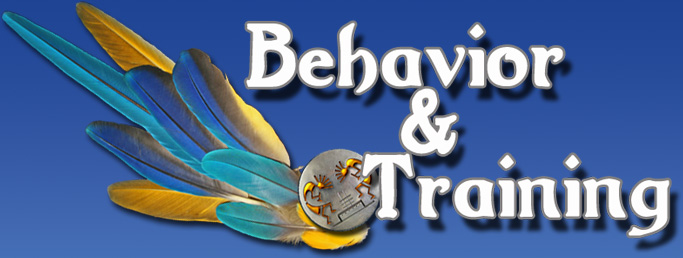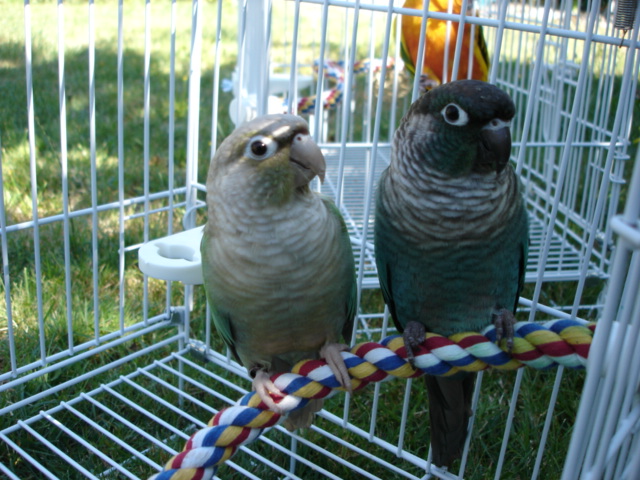 |
 |
One of the more interesting experiences in my life was going to a seminiar on sexual behaviors in parrots put on by Dr. Brian Speer (lots of letters after his name, co-wrote Birds for Dummies) hosted by Mickaboo. Ironically, I went to this a few months before I got Buffy, and got to put my knowledge to work.
Listening to him talk really drove home a lot of issues for me, and the longer I've looked at and worked with parrots, the more I am absolutely certain he's right. We give our parrots seriously mixed signals.
An example, if I may. You're out seeing a movie with your best friend, who is of a gender that you prefer. Said friend raises the arm rest between the two of you at the theater, and scoots over to sit right next to you, hip to hip. Friend puts his or her hand on your leg, rubs it in a sensual way, puts his or her arm around you, leans in close to whisper flirtily in your ear. This best friend is clearly giving signals that he or she finds you attractive, right? How would you feel if you thought, 'Wow, this is great', and attempted to kiss the friend, and he or she slapped you, screamed at you, made a giant fuss, and stormed out? Confused, yes? What if said friend did this every time you were together? Lead you on, then struck you down. You'd probably be either really really confused or really really pissed off. Or both.
Documentaries and research on parrots in the wild have taught us a number of things. First, that parrot courting behaviors are ritualistic, sensual, and have a lot of things in common between species. When two parrots are thinking of having a little parrot sex and possibly making parrot babies, they do things. The female often solicits food from the male with the same gesture as a baby (wings fluttered and back, crouched, head tipped up). The male feeds her as he would a baby. They do a lot of very sensual preening, particularly paying attention to parrot erogenous zones like the back and the area beneath the wings and around the vent. They stay together, often touching, almost always doing things in the same way at the same time, and never out of sight of each other unless one is nesting. And they also mate, where the male stands on top of the female's back, twists sideways as she moves her tail out of the way, and they rub cloacas together until the male ejaculates.
In comparison, if you look at a flock of parrots, you will see that although they do things together, they rarely are touching, they do not have the 'weird symmetry' thing going (I'll show a picture below), and they often preen each other in the places they can't (like the head), but the long and sensual snuggling doesn't occur. There's a pretty clear line between 'we're friends' and 'I'd like to make babies with you'. And humans cross it with our parrots constantly.
In what I said above, there were a few specific mating behaviors.
The female solicits feeding from the male, who feeds her nice warm mushy food from his beak. And, I can promise you, when I'm feeding Buffy warm handfeeding formula off a spoon, she is quite positive that we're going to make babies together. She displays, solicits with wings back, and generally explains to me that I would be a GREAT baby-maker. The male parrots who I feed do not seem to have the same reaction, they just want the handfeeding formula because it tastes great. I have to carefully balance my triggers for Buffy because she's so easily hormonal, and unfortunately, handfeeding her is a big one. I do it anyways because otherwise she'd starve.
Lots and lots of sensual preening, particularly in 'sexy' places. The long smooth stroke from the top of a parrot's head, down and over its back, often curling fingers around the tail and possibly brushing the parrot's vent is an extremely sexual behavior, and yet people do it all the time. We don't act like flockmates, helping out with the tough areas to scratch, we act like mates, sensually petting them and getting the bird all sexed up (and then being pissy when they start acting like our mates).
Weird symmetry and always together.

These two characters are our bonded pair of green cheek conures. As you can see from the other pictures I took that day, here and here, they are always mirror images of each other. Always. It is very rare that they are any more than that distance apart, and Stilton spends an enormous amount of time feeding Anisette, and both of them preen each other in a way that is distinctly sensual, particularly during times of high hormones.
In addition to that, they are always together, always touching or almost touching. Flockmates in the wild tend to keep in contact with each other but they are not constantly touching -- just like most people might sit and chat with their best friend, but they hold hands with their lover. When we spend all of our time with our parrot physically on us, never letting them go off and be independent souls and play by themselves, we are reinforcing the fact that we are their mates.
We provide a great environment for reproduction. Lots and lots of light, up to 16 or 18 hours a day depending, lots of fresh food and high fat treats, often little huts to sleep in and make nests in, letting them stand on top of their nest (their cage) and defend it from all who come near. These are all great triggers for breeders, but not all of us want to have little parrots around (and most of us don't have the appropriate sexes and species that it is even possible!)
Ever heard of this scenerio? My parrot is sitting on my shoulder and attacks another person when they walk into the room or will attack me if another person walks into the room. Your parrot thinks that you are his or her mate, and the other person is either a rival or a threat. By attacking them, they're making sure they don't lose you (much like men having fistfights over a woman), and by attacking you, they're saying 'Let's fly away together, this new person is scary!'
How about when your parrot screams for hours when you walk out of the room? You're both the parrot's flock and the parrot's mate, and you just abandoned them. To a parrot, that usually means death, so they're reasonably freaked out by the subject.
Although everyone loves their avian vet, and wants to buy them houses, egg binding, excessive egg laying, and prolapsed cloacas are really not cheap things to fix. Some of them are not fixable -- the foster mom of my macaw has dealt with her U2's problem with prolapsing because she strains so hard whenever she gets hormonal for years. It's an ongoing struggle.
Let me state here that all of the things listed may not have a single effect on your parrot. They may simply be dense to mate related behaviors or not care or not feel the need to be obnoxious about it. The advice that I've found works for me may not even matter in some cases. But, in others, it may make a big difference. Take what you want and leave the rest behind, do what works for you. This is what has worked for me.
We do and have done this with all of our parrots, and each of them have a preference for a person. What, then, if your parrot already thinks you're their mate and attacks your SO?
Stop all mating triggers immediately and work to balance out the parrots feelings some. The least favored person does all the really really cool things, the most favored person does all the terrible things.
As an example, if I had a parrot that prefered my partner, I would make a list of all of their favorite things and all of their least favorite things. I would do their favorite things and my partner would do their least favorite things. In the end, the parrot would very likely have a balanced level of affection for us both, which is one way to prevent a one person bird.